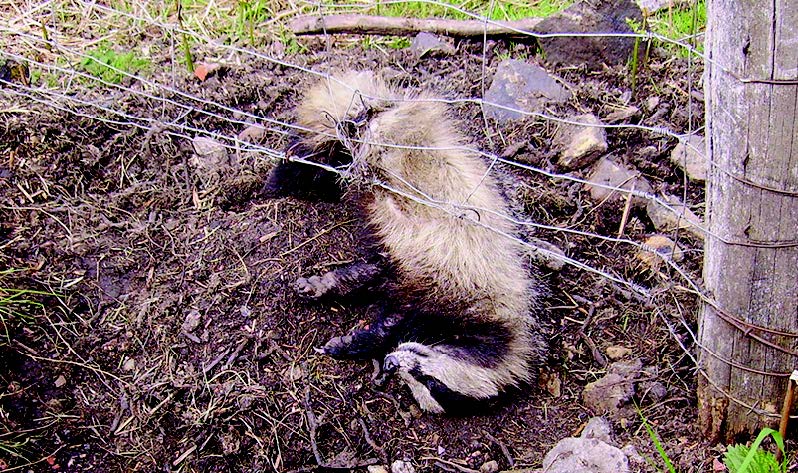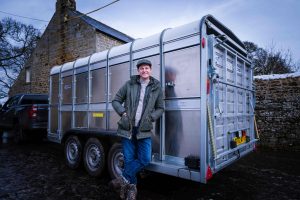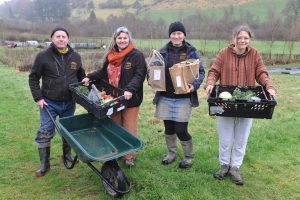
THE WELSH GOVERNMENT issued a press release last week hailing its success in delivering 5,000 vaccinations against Bovine TB (bTB) in the Intensive Action Area against the disease in North Pembrokeshire, South Ceredigion, and North-West Carmarthenshire.
The press release read: ‘More than 5,000 doses of badger vaccination have been administered to animals inside the Intensive Action Area (IAA) in West Wales over the past four years. We are now half way through the fourth year of the Welsh Government’s five-year badger vaccination project in parts of Pembrokeshire, Carmarthenshire and Ceredigion, which forms part of a wider programme of work to eradicate TB from cattle in Wales.
‘The Deputy Minister for Farming and Food, Rebecca Evans, said: “Since 2010 we have introduced a number of additional measures in the IAA because it was identified as having some of the highest rates of incidence of TB in Europe.
“We are now half way through 2015’s round of the vaccination project and provisional results indicate we have successfully delivered over 5,000 doses of the vaccine in the IAA across the four years”.’
The statistics accompanying the summary were released at the same time.
The Herald delved into the data to establish what it told us about bTB rates and the effectiveness of the vaccination programme.
The history of bTB control
It is 55 years since the whole of the UK became attested on October 1, 1960. Each cattle herd was certified as being subject to regular tuberculin testing with immediate slaughter of any reactors. Progress was maintained throughout the 1960s and 1970s.
The ‘clean ring strategy’ was a badger culling strategy introduced in 1982. It involved cage trapping badgers on land occupied by affected cattle herds, then on adjoining land, expanding outwards until no further infected animals were captured. It was abandoned in 1986 as being non cost-effective.
Between 1986 and 1997, the UK Government pursued a strategy in which badgers were cage-trapped and shot. However, the strategy was only piecemeal, largely because of pressure from animal charities and single-issue pressure groups that meant that only badgers on land occupied by the affected herd would be culled.
Bearing in mind current claims that culling badgers is ineffective because of the proposition that badgers would simply leave the culling area to go to a neighbouring area, the methodology adopted between 1986 and 1997 in order to prevent wider scale slaughter of badgers appears both flawed and naïve: a strategy doomed to fail, and predictably so.
Culling in other countries
In New Zealand the success of culling the principal vector for the disease, the possum, has been markedly successful.
In 1990 the proportion of TB in cattle was about 7 times greater than it was in Great Britain. However in 1997 the proportions were about equal. By 2011, the proportion in New Zealand is about 40 times less than what it is in Great Britain.
Since the early nineties, control of the principal wildlife vector, the possum has increased whilst in Great Britain since 1986 control of the principal wildlife vector, the badger, has reduced.
The method of culling in Ireland relies on the use of snares and the subsequent shooting of trapped badgers. That method, widely condemned as cruel, is expressly forbidden in the UK. The effectiveness of the range of bTB measures – including culling – adopted in Ireland has driven rates of bTB infection in herds to their lowest ever level.
Bovine TB figures have, however, also fallen in Northern Ireland, were no licensed culling has taken place. That fact has been alighted upon by those opposed to a cull as evidence of the ineffectiveness of shooting badgers in order to control bTB. However, bTB rates are still substantially higher in Northern Ireland than in the Republic of Ireland: in 2013 6.4 per cent of cattle herds tested positive in Northern Ireland compared to 3.8 per cent south of the border.
As might be ruefully observed, the validity of statistical evidence and the science deployed by those on either side of the culling debate is likely to remain subjective and views remain entrenched. Wildlife and animal charities will continue to deride culling, while those who deal with the personal and economic fallout of bTB will favour it.
The Welsh decision
It was against the background of apparent comparative success of culling in other countries that the Welsh Government decided to begin a five year vaccination trial in West Wales and worth recalling that the Welsh Government embarked upon a vaccination programme as very much a second preference.
In 2012, Welsh Labour abandoned a previous policy, formed in coalition with Plaid Cymru, which supported a badger cull and decided to pursue a policy of vaccination. In doing so, it was criticised by the then Chair of the British Veterinary Association for ignoring scientific evidence supporting a cull and accused of ‘cowardice’ in the face of a celebrity-backed campaign against the cull and pressure from animal charities.
The decision not to proceed was described as a betrayal of farmers whose herds remain affected by the reservoir of bTB in the wild badger population.
But what, it is fair to ask, is the Welsh Government’s ‘Plan B’?
What if the data suggests that vaccination is no more effective than doing nothing?
A farmer’s experience
The Herald spoke to one farmer, who provided his observations on life in the IAA on condition of strict anonymity.
The farmer told us: “My dairy herd has suffered from bTB for 12 years. In 2012, badgers began to be vaccinated in the area, along with strict cattle control.
“I, like many farmers find this to be a costly exercise which doesn’t reach the root of the problem, the over population of badgers in the area.
“The stricter cattle controls and improved biosecurity measures also brought in in the IAA looks to move the blame of bTB onto the farmers, which is unfair.
“Because of the desperation I face with losing cattle to slaughter because of bTB and falling milk prices, I am left with no alternative but to shoot badgers which are on my land. “This is a population control measure and I take no pleasure in the culling of an animal. It’s either the badger or my cattle, and for the sake of my family and my income, it’s the badger.”
Data and dates During the vaccination programme the absolute incidence of bTB has fallen markedly, with numbers of affected cattle falling. One key piece of data is not encouraging when it comes to weighing the effectiveness of the vaccination programme. In the period immediately preceding the vaccination programme the incidence bTB had fallen even more sharply.
Bovine TB cases had climbed sharply over the years to 2008/09, topping out at 29% per hundred head of cattle in the IAA that year. The rate of detected infection in the last full year in the most recent Welsh Government report (2014/15) shows that infection rates remain above where they were in 2006/2007, when they were at around 16% and that in the current control area was 8%.
After an initial increase in incidence following the introduction of interventions in the IAA, incidence has been decreasing since 2011/12. Incidence has also decreased in the Control Area (CA) in the last year, halving from 12 % to 6 %. In 2013/14, there were three times as many new bTB incidents per 100 unrestricted herds in the IAA (18 %) than in the CA (6 %,).
That means that the gap in the incidence of positive tests in the control area, where no vaccinations have been trialled, and the Intensive Action Area where they have has widened over the course of the vaccination programme. From the start of the IAA in 2010/11, and historically judging by the Welsh Government’s own data, the ratio had been around two to one. While one would expect the gap to narrow if vaccination were more effective that not vaccinating, the gap between the incidence in the IAA and the control area has widened.
We asked the Welsh Government about the issue the above analysis presented. A Welsh Government spokesperson said, “The downward trend in levels of bovine TB in the Intensive Action Area is encouraging and is broadly in line with the trend seen in other parts of Wales. We know that it may take years to fully see the benefits of some of our additional measures in the area, which includes six monthly testing and badger vaccination. Therefore it is too soon to draw any conclusions on the effectiveness of the measures in the IAA.”

















Add Comment